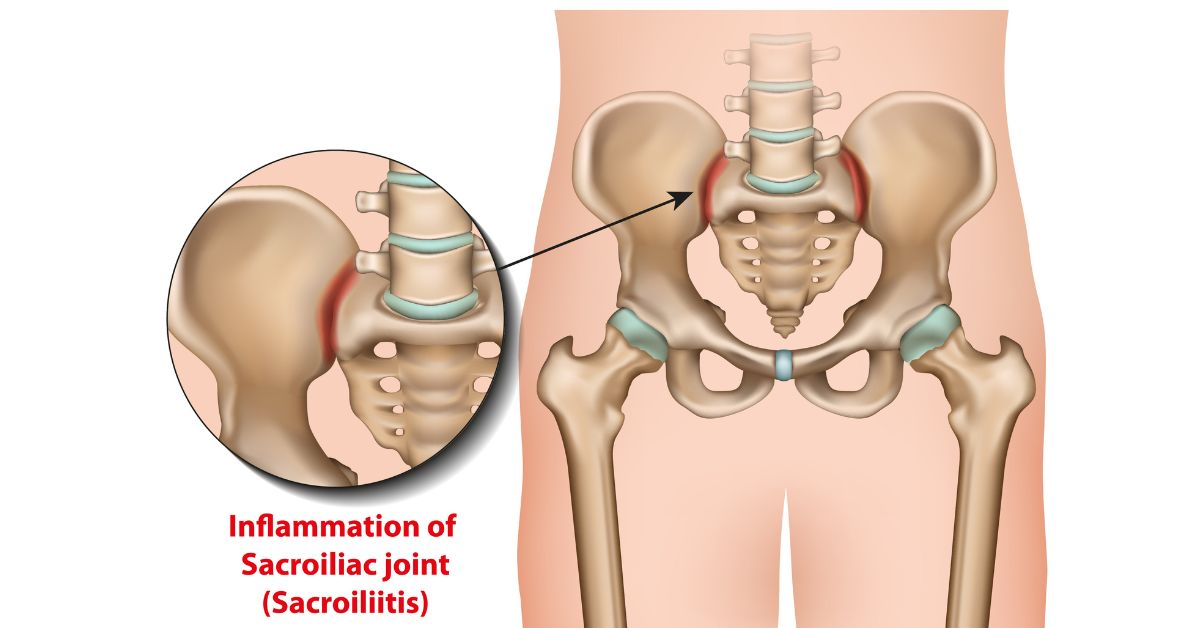Sacroiliitis : Symptoms, Causes, Treatment, Home Remedies & Exercises


Overview
The sacroiliac joints connect the pelvis and the lower spine. Sacroiliitis is the swelling of either one or both sacroiliac joints, causing pain in the buttocks or lower back and spreading to either or both legs. The treatment methods for sacroiliitis include physical therapy, radio frequency ablation, and steroid injections into the sacroiliac joint.
This blog is a comprehensive understanding of sacroiliitis, its causes, symptoms, treatment, and prevention.
What is sacroiliitis?
Sacroiliitis is the inflammation of either one or both sacroiliac joints in the area where the lower spine and pelvis join. It generally causes lower back pain and pain in the buttocks or thighs. Sacroiliitis is challenging to diagnose because several other conditions result in pain at the exact locations.
What are the symptoms of sacroiliitis?
Sacroiliitis symptoms can be similar to that of other lower back issues. Its most common symptom is a pain in the hip, buttocks, lower back, and down the legs. Sometimes a low-grade fever accompanies these symptoms. The pain generally worsens after standing for long periods, going up and down the stairs, and running or walking with long strides.
When should you consult the doctor?
Consult the doctor for a thorough evaluation when you have ongoing pain in the thigh, buttock, or lower back.
Request an appointment at Apollo Hospitals
What are the causes of sacroiliitis?
The are many causes of sacroiliitis, including:
- Gout
- Injury to the sacroiliac joints from a car accident or falling
- Joints becoming loose at the time of pregnancy in preparation for birth
- An altered gait during pregnancy
- Conditions such as osteoarthritis and ankylosing spondylitis (inflammatory arthritis)
- An infected sacroiliac joint (very rare)
- Prevailing back or spine issues
What are the complications of sacroiliitis?
If left untreated, it leads to mobility loss in a few individuals. The untreated pain can also disrupt the patient’s sleep and result in psychological conditions such as depression. Sacroiliitis related to ankylosing spondylitis can progress over time, leading to spinal fusion and stiffening of the vertebrae.
How is sacroiliitis treated?
The treatment method depends on the causes, signs, and symptoms of sacroiliitis.
Medications
The doctor can suggest the following medications based on the cause of the pain:
- Pain relievers – the doctor can prescribe stronger pain relievers when over-the-counter pain medications do not provide sufficient relief.
- Muscle relaxants – Medications such as cyclobenzaprine help decrease the muscle spasms often related to sacroiliitis.
- Tumour Necrosis Factor inhibitors – TNF inhibitors, including adalimumab, etanercept, and infliximab, often assist in relieving sacroiliitis related to ankylosing spondylitis
Therapy
The doctor or physical therapist can teach range-of-motion and stretching exercises to people to maintain joint flexibility. They may also teach strengthening exercises that make the muscles more stable.
Surgical procedures and other methods
The doctor can recommend other procedures if the methods mentioned have not reduced pain; they can include the following:
- Joint injections – the doctor can inject corticosteroids into the joint to decrease inflammation and pain. Steroids can weaken the bones and tendons of the joints. Therefore, patients may get only a few joint injections in a year.
- Radio frequency denervation – radio frequency energy could damage or eliminate the nerve tissue causing the pain.
- Electrical stimulation – transplanting an electrical stimulator into the sacrum can minimise pain caused by sacroiliitis.
- Joint fusion – fusing the two bones with metal may reduce sacroiliitis pain. However, doctors rarely use surgery to treat sacroiliitis.
What are the home remedies and exercises that can help?
Home remedies and exercises can help reduce sacroiliitis, apart from medications and other procedures. They include:
- Rest – avoiding movements that worsen sacroiliitis. Resting can reduce a patient’s inflammation.
- Ice and Heat – Alternatively, placing an ice or heat pack on the affected area can relieve sacroiliitis.
- Hip flexion exercises – patients must lie on the back with their legs on top of a box or a few pillows, cross their legs over the other, squeeze both the legs together, and release them.
Conclusion
Sacroiliitis is a health condition that leads to the inflammation of one or both sacroiliac joints. This inflammation may result in pain in the lower back, buttocks, and one or both legs. Pregnancy, trauma, and infection can also cause sacroiliitis. The treatment may be based on the long-term management of symptoms.
Frequently Asked Questions
Is sacroiliitis preventable?
Sacroiliitis is not preventable. However, people can prevent or minimise their symptoms by avoiding activities such as running or climbing stairs because they cause pain.
How is sacroiliitis diagnosed?
The doctor generally diagnoses sacroiliitis with the help of physical tests, blood work, X-rays, MRI scans or CT scans. They also use steroid injection as both a diagnostic test and treatment.
What are the outcomes for people after receiving treatment for sacroiliitis?
Most patients suffering from sacroiliitis manage their pain and regain mobility after receiving treatment.
© Copyright 2024. Apollo Hospitals Group. All Rights Reserved.
 +91 8069991061
Book Health Check-up
Book Health Check-up
Book Appointment
Book Appointment
+91 8069991061
Book Health Check-up
Book Health Check-up
Book Appointment
Book Appointment







